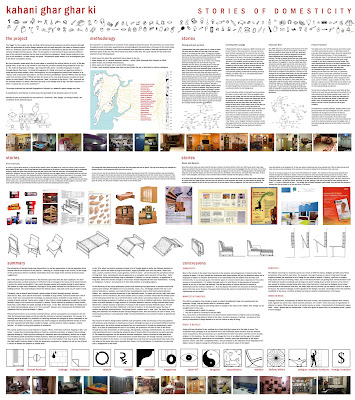Chaitanya shared an interesting critique on Corrra's buildings. He says, Correa's buildings are very unclear, they do not have a diagram. What he meant was they one gets 'lost' while moving in the building.
Taking specific examples, he said that many buildings rely on external media like painting, sculptures to communicate. For example, if the whole of Cidad-de-Goa was to be painted white, the building would lose all its quality. Similarly, if JKK lost colour, it would be a different building. However, this does not happen always.
Kanchanjunga, he says doesnot even have a clarity of 'entrance'. You wonder when you enter the building, "where to go"? I agree to this, having seen and experienced the building recently. Adding to this, each flat in the building is different, so you constantly keep losing orientation. (imagine a maid working at 3 houses in the same building! she would go mad!!).
One standard critique that everyone has for Correa's buildings is that they are not detailed enough. The edges of the buildings, the railings, the steps, or even the windows or any damn thing. Nothing looks 'tight' in Chaitanya's words. Also, although Correa may be a world famous architect, he has not offered anything to India for which "people would come from outside to have a look at". He was perhaps mentioning about the 'iconicity' of a building.
Another point he made was that his buildings do not have a 'tropical' character. A tropical building would be a building with a private-semi open verandah (long) and then opening to sky building. This is where, he says, the courtyard typology fails. His buildings don't even speak of the tropical character through colours - which are bright and whites. Rather, he chooses earthy and more rural colours.
His remarks are relevant.
However, in the past week, Correa has hinted answers to all these questions in our conversations with him. So I will defend all the critiques from Correa's side one by one:
Correa operates through the Hindu ideas of myth and reality. He believes in the hindu philosophy of the universe and this philosophy accepts things with their chaos. There is no black and white like the western philosophies of how we came into being. Thus, although his buildings start with a process of structuring space, he ends up making complex movements in the building that resonate with the central idea of the philosophy of ordering chaos (which he explains as multiple layers of order).
While talking, he said that he loves to introduce paintings, suclptures on walls because they, he assumes, are not a separate element of the building. He says that in our culture, a person staying in the village feels that painting is an integral part of the process of house-making (like the warli, madhubani, kutch houses). He also mentioned that even critics like Kenneth Frampton are not able to appreciate the paintings he makes on his buildings, because there is a lack of cultural experience.
"I work in a country where no one cares for buildings." he says.
further, he says that "I did most of the Government projects using the contractors of the State Public Wards Department, like the Sabarmati Gandhi Ashram or the Vidhan Bhavan and the Bharat Bhavan Bhopal. You can not expect pristine lines and finishing when you are working with local people. These are not priavte clients which can spend so much on precision. Infact, I feel the unfinished-ness adds to the quality of the buildings. Even the indian khadi fabric looks beautiful because it doesnot form clean straight lines. The undulating warps and wefts give character to the cloth, it echoes our culture." And he also ties it up with the philosophy of Hindu culture/philosophy. But those interested in seeing crisply finished Correa buildings, see the Champalimaud Brain and Scientific Research Centre in Portugal. Here, the client was a private company and they could afford being precise. To sum it up, he himself feels very sorry for all his ill-maintained buildings.
So I shall keep updating more of such discussions and debates whenever possible.
Time for a one liner:
"Manmohan Singh is a cross between a kitten and a mouse"
(he acted it out too)!
























